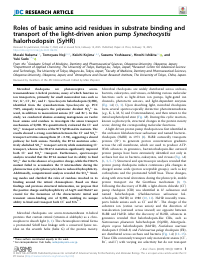Roles of basic amino acid residues in substrate binding and transport of the light-driven anion pump Synechocystis halorhodopsin (SyHR)
Permalink : https://ousar.lib.okayama-u.ac.jp/68600
| フルテキストURL | |
| 著者 |
Nakama, Masaki
Graduate School of Medicine, Dentistry and Pharmaceutical Sciences, Okayama University
Noji, Tomoyasu
Department of Applied Chemistry, The University of Tokyo
Kojima, Keiichi
Graduate School of Medicine, Dentistry and Pharmaceutical Sciences, Okayama University
ORCID
Kaken ID
researchmap
Yoshizawa, Susumu
Atmosphere and Ocean Research Institute, The University of Tokyo
Ishikita, Hiroshi
Department of Applied Chemistry, The University of Tokyo
Sudo, Yuki
Graduate School of Medicine, Dentistry and Pharmaceutical Sciences, Okayama University
ORCID
Kaken ID
researchmap
|
| 抄録 | Microbial rhodopsins are photoreceptive seventransmembrane a-helical proteins, many of which function as ion transporters, primarily for small monovalent ions such as Na+, K+, Cl-, Br-, and I-. Synechocystis halorhodopsin (SyHR), identified from the cyanobacterium Synechocystis sp. PCC 7509, uniquely transports the polyatomic divalent SO42- inward, in addition to monovalent anions (Cl- and Br-). In this study, we conducted alanine-scanning mutagenesis on twelve basic amino acid residues to investigate the anion transport mechanism of SyHR. We quantitatively evaluated the Cl-and SO42- transport activities of the WT SyHR and its mutants. The results showed a strong correlation between the Cl-and SO42- transport activities among them (R = 0.94), suggesting a shared pathway for both anions. Notably, the R71A mutation selectively abolished SO42- transport activity while maintaining Cl- transport, whereas the H167A mutation significantly impaired both Cl-and SO42- transport. Furthermore, spectroscopic analysis revealed that the R71A mutant lost its ability to bind SO42- due to the absence of a positive charge, while the H167A mutant failed to accumulate the O intermediate during the photoreaction cycle (photocycle) due to reduced hydrophilicity. Additionally, computational analysis revealed the SO42- binding modes and clarified the roles of residues involved in its binding around the retinal chromophore. Based on these findings and previous structural information, we propose that the positive charge and hydrophilicity of Arg71 and His167 are crucial for the formation of the characteristic initial and transient anion-binding site of SyHR, enabling its unique ability to bind and transport both Cl-and SO42-.
|
| キーワード | microbial rhodopsin
anion transport
retinal
membrane protein
photobiology
|
| 発行日 | 2025-04
|
| 出版物タイトル |
Journal of Biological Chemistry
|
| 巻 | 301巻
|
| 号 | 4号
|
| 出版者 | Elsevier
|
| 開始ページ | 108334
|
| ISSN | 1083-351X
|
| 資料タイプ |
学術雑誌論文
|
| 言語 |
英語
|
| OAI-PMH Set |
岡山大学
|
| 著作権者 | © 2025 The Authors.
|
| 論文のバージョン | publisher
|
| PubMed ID | |
| DOI | |
| Web of Science KeyUT | |
| 関連URL | isVersionOf https://doi.org/10.1016/j.jbc.2025.108334
|
| ライセンス | http://creativecommons.org/licenses/by/4.0/
|
| 助成機関名 |
Japan Society for the Promotion of Science
科学技術振興機構
|
| 助成番号 | JP21K15054
JP23K27142
JP23H02444
JP21H02446
JP21H00404
JPMJSF23BA
|
